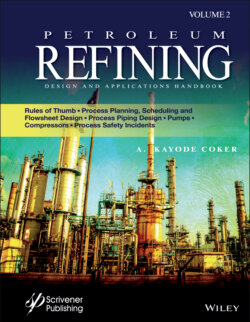Читать книгу Petroleum Refining Design and Applications Handbook - A. Kayode Coker - Страница 28
FLUIDIZATION OF PARTICLES WITH GASES
Оглавление1 1. Properties of particles that are conducive to smooth fluidization include rounded or smooth shape, enough toughness to resist attrition, sizes in the range of 50–500 µm diameter, and a spectrum of sizes with ratio of largest to smallest in the range of 10–25.
2 2. Cracking catalysts are members of a broad class characterized by diameters of 30–150 µm, density of 1.5 g/ml or so, and appreciable expansion of the bed before fluidization sets in, minimum bubbling velocity greater than minimum fluidizing velocity, and rapid disengagement of bubbles.
3 3. The other extreme of smoothly fluidizing particles are typified by coarse sand and glass beads, both of which have been the subject of much laboratory investigation. Their sizes are in the range of 150–500 µm, densities 1.5–4.0 g/ml, have small bed expansion and about the same magnitudes of minimum bubbling and minimum fluidizing velocities, and they also have rapidly disengaging bubbles.
4 4. Cohesive particles and large particles of 1 mm or more do not fluidize well and usually are processed in other ways.
5 5. Rough correlations have been made of minimum fluidization velocity, minimum bubbling velocity, bed expansion, bed level fluctuation, and disengaging height. Experts recommend, however, that any real design be based on pilot-plant work.
6 6. Practical operations are conducted at two or more multiples of the minimum fluidizing velocity. In reactors, the entrained material is recovered with cyclones and returned to process. In driers, the fine particles dry most quickly so the entrained material need not be recycled.
